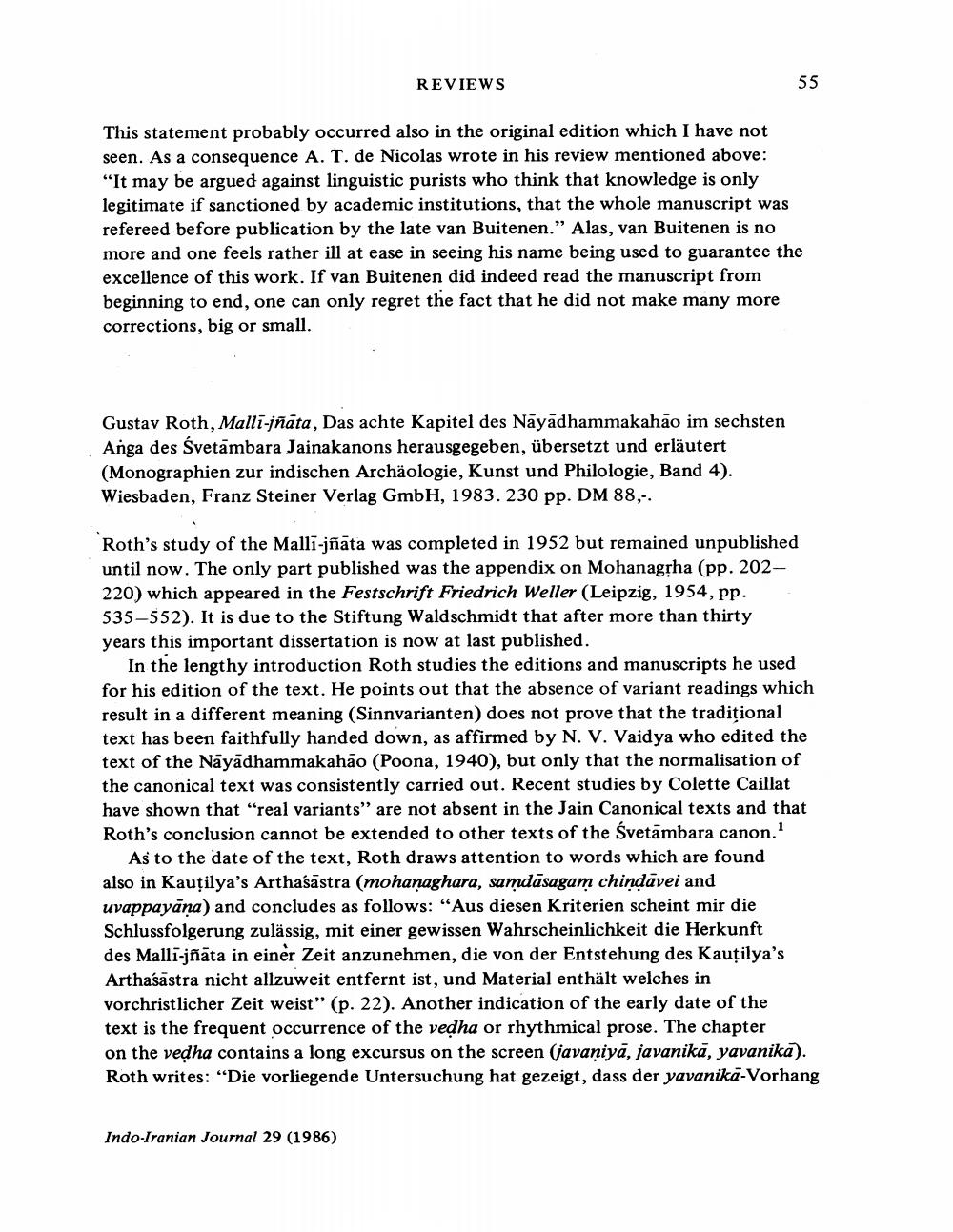Book Title: Reviews Of Diffeent Books Author(s): J W De Jong Publisher: J W De Jong View full book textPage 7
________________ REVIEWS This statement probably occurred also in the original edition which I have not seen. As a consequence A. T. de Nicolas wrote in his review mentioned above: "It may be argued against linguistic purists who think that knowledge is only legitimate if sanctioned by academic institutions, that the whole manuscript was refereed before publication by the late van Buitenen." Alas, van Buitenen is no more and one feels rather ill at ease in seeing his name being used to guarantee the excellence of this work. If van Buitenen did indeed read the manuscript from beginning to end, one can only regret the fact that he did not make many more corrections, big or small. Gustav Roth, Malli-jñāta, Das achte Kapitel des Nayadhammakahão im sechsten. Anga des Śvetambara Jainakanons herausgegeben, übersetzt und erläutert (Monographien zur indischen Archäologie, Kunst und Philologie, Band 4). Wiesbaden, Franz Steiner Verlag GmbH, 1983. 230 pp. DM 88,-. 55 Indo-Iranian Journal 29 (1986) Roth's study of the Malli-jfiäta was completed in 1952 but remained unpublished until now. The only part published was the appendix on Mohanagṛha (pp. 202220) which appeared in the Festschrift Friedrich Weller (Leipzig, 1954, pp. 535-552). It is due to the Stiftung Waldschmidt that after more than thirty years this important dissertation is now at last published. In the lengthy introduction Roth studies the editions and manuscripts he used for his edition of the text. He points out that the absence of variant readings which result in a different meaning (Sinnvarianten) does not prove that the traditional text has been faithfully handed down, as affirmed by N. V. Vaidya who edited the text of the Näyādhammakahão (Poona, 1940), but only that the normalisation of the canonical text was consistently carried out. Recent studies by Colette Caillat have shown that "real variants" are not absent in the Jain Canonical texts and that Roth's conclusion cannot be extended to other texts of the Svetambara canon.1 As to the date of the text, Roth draws attention to words which are found also in Kautilya's Arthasästra (mohanaghara, samdāsagam chindāvei and uvappayāna) and concludes as follows: "Aus diesen Kriterien scheint mir die Schlussfolgerung zulässig, mit einer gewissen Wahrscheinlichkeit die Herkunft des Malli-jñāta in einer Zeit anzunehmen, die von der Entstehung des Kautilya's Arthasästra nicht allzuweit entfernt ist, und Material enthält welches in vorchristlicher Zeit weist" (p. 22). Another indication of the early date of the text is the frequent occurrence of the veḍha or rhythmical prose. The chapter on the vedha contains a long excursus on the screen (javaṇiyā, javanikā, yavanika). Roth writes: "Die vorliegende Untersuchung hat gezeigt, dass der yavanika-VorhangPage Navigation
1 ... 5 6 7 8 9 10 11 12 13 14 15 16 17 18 19 20 21 22 23 24 25 26 27
